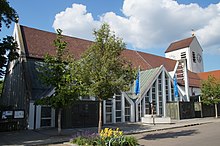St. Konrad (Regensburg)
St. Konrad is the Catholic parish church in the Regensburg district of Konradsiedlung at St.-Konrad-Platz 5.
history
The church was built in 1935/36 according to plans by the local architect Max Wittmann on a hill on the settlement area. The church was conceived as a pastoral care center for the National Socialist model settlement Schottenheim . The artistic equipment was created by local forces. After the end of the Second World War , the patron saint of the church, lay brother Konrad von Parzham , gave its name to the entire settlement. After the congregation had grown significantly, the nave was extended in 1952 by Hans Beckers . On October 5, 1953, the church was raised to a parish. After a further strong growth of the congregation and the new liturgical requirements for the church design by the Second Vatican Council , the church building was again enlarged with an extension in 1966/1967 according to plans by the government architect Franz Günthner. The extended nave was demolished and replaced by a glass tent roof construction in a modern design language. Today the community includes the Konradsiedlung as well as parts of Wutzlhofen and the Brandlberg.
The church does not have its own cemetery. The parish members are therefore partly buried in the cemetery of Reinhausen , which actually belongs to the parish of St. Josef (Reinhausen) , as well as in the other Regensburg cemeteries. The All Saints 'Day and All Souls ' Day celebrations are also celebrated in the Reinhausen cemetery; the parishes alternate with the celebration or concelebration every year.
architecture
The preserved part of the church is a gable-independent hall building with a steep pitched roof, retracted choir with choir tower and double gables at the side in a grid construction . In the west, the newly designed reinforced concrete structure in the shape of a tent roof adjoins. The five gable walls are decorated with glass paintings based on designs by Erich Schickling . The people's altar is erected on the raised altar island at the interface with the historical building . The grouped arrangement of the pews allows worshipers to gather close to the altar. The former apse now houses the organ and the space for the church choir . The grown figurines from the old church were used again in the redesign.
Organs
Organ of the parish church
In 1967 Eduard Hirnschrodt set up a new work in the enlarged church: the organ , originally with 36 sounding stops on three manuals and a pedal with a cone door and an electro-pneumatic action, was a larger instrument in the company's history. Parts of Willibald Siemann's predecessor organ were also reused for this purpose. It has been expanded several times. Today's disposition is as follows:
|
|
|
|
||||||||||||||||||||||||||||||||||||||||||||||||||||||||||||||||||||||||||||||||||||||||||||||||||||||||
- Coupling : II / I, III / I III / II, I / P, II / P, III / P, general coupling
- Playing aids : 3 free combinations , crescendo roller , swell kick, crescendo off, general tongues off, man. 16 ′ from, 2 free piano pedal combinations and single tongue storage
Organ of the St. Konrad Chapel
In the 90s of the last century the local company August Hartmann built an organ with attached pedal for this room. The disposition is:
|
Manual C – f 3
|
||
| 1. | Covered | 8th' |
| 3. | Reed flute | 4 ′ |
| 4th | Principal | 2 ′ |
| 5. | Fifth | 1 1 ⁄ 3 ′ |
| 5. | mixture | 1 ′ + 1 ⁄ 3 ′ |
Bells
There is a four-part bell in the bell tower of the church . It sounds in the tone sequence Es 1 gb 1 as 1 bb 1 . The steel bells were cast by the Bochumer Verein für Gussstahlfabrikation in 1935. It is the only steel bell in the city of Regensburg.
Furthermore, there is a small carillon made of four bronze bells on a bell carrier at the church.
literature
- Martin Ortmeier: Catholic parish church of St. Konrad Regensburg (= Small Art Guide No. 1466). Schnell and Steiner, Munich & Zurich 1984.
Web links
Coordinates: 49 ° 2 '26.3 " N , 12 ° 7' 34.8" E
Individual evidence
- ↑ a b Martin Ortmeier: Catholic parish church St. Konrad Regensburg (= Small Art Guide No. 1466). Schnell and Steiner, Munich & Zurich 1984.
- ↑ www.glockenklaenge.de: Regensburg-Konradsiedlung, parish church St. Konrad. Retrieved April 3, 2018 .


